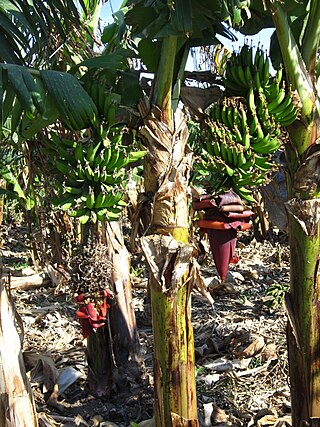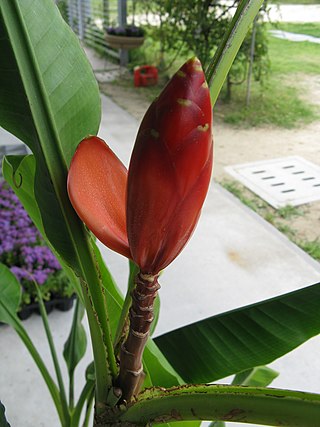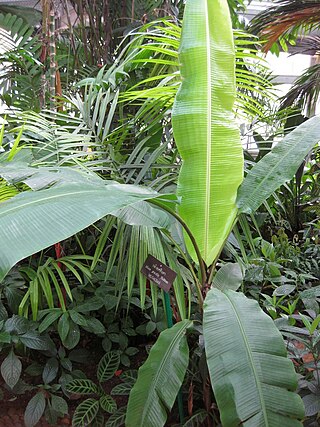
Musaceae is a family of flowering plants composed of three genera with about 91 known species, placed in the order Zingiberales. The family is native to the tropics of Africa and Asia. The plants have a large herbaceous growth habit with leaves with overlapping basal sheaths that form a pseudostem making some members appear to be woody trees. In most treatments, the family has three genera, Musa, Musella and Ensete. Cultivated bananas are commercially important members of the family, and many others are grown as ornamental plants.

Musa is one of three genera in the family Musaceae. The genus includes 83 species of flowering plants producing edible bananas and plantains. Though they grow as high as trees, banana and plantain plants are not woody and their apparent "stem" is made up of the bases of the huge leaf stalks. Thus, they are technically gigantic herbaceous plants. Musa species are used as food plants by the larvae of some Lepidoptera species, including the giant leopard moth and other Hypercompe species, including H. albescens, H. eridanus, and H. icasia.
Musa maclayi is a species of seeded banana native to Papua New Guinea and the Solomon Islands. It is placed in section Callimusa. It is regarded as one of the progenitors of the Fe'i banana cultivars.
Musa × alinsanaya is a Malesian tropical plant in the banana family (Musaceae), native to the Philippines. Only formally named in 2004, it is considered to be a hybrid between Musa banksii and Musa textilis. The flower bud is shiny green with purple inside. It produces small fruit with a high proportion of seeds.
Musa muluensis is a plant in the banana and plantain family. It is native to tropical Asia; found only in Sarawak in Malaysia. It is placed in section Callimusa, members of which have a diploid chromosome number of 2n = 20.

Musa coccinea, commonly known as scarlet banana or red-flowering banana, is a species of flowering plant in the banana and plantain family Musaceae, native to tropical China and Vietnam. It is a bat-pollinated evergreen perennial, placed in section Callimusa, having a diploid chromosome number of 2n = 20.

Musa × paradisiaca is the accepted name for the hybrid between Musa acuminata and Musa balbisiana. Most cultivated bananas and plantains are triploid cultivars either of this hybrid or of M. acuminata alone. Linnaeus originally used the name M. paradisiaca only for plantains or cooking bananas, but the modern usage includes hybrid cultivars used both for cooking and as dessert bananas. Linnaeus's name for dessert bananas, Musa sapientum, is thus a synonym of Musa × paradisiaca.

Musa beccarii is a species of wild banana, found in Malaysia, in Sabah. It is placed in section Callimusa.

Musa jackeyi is a species of wild banana in the Banana Family (Musaceae).. It is placed in section Callimusa. It has only a small native range in north-east Queensland, Australia. It is the second tallest banana species after Musa ingens, having petioles (stalks) up to 33 ft (10 m) in height, topped by laminae (blades) 14.5 ft (4.4 m) long by 2 ft (61 cm) in width, for a total height of up to 47.5 ft (14.5 m). It resembles the cultivated bananas called "fe'i" or "fehi", having an upright rather than a drooping fruit stalk, with the green terminal bud pointing upwards, and sap which is reddish in colour.
Musa azizii is a species of wild banana, native to Sarawak, Malaysia. It is placed in section Callimusa, having a diploid chromosome number of 2n = 20.
Musa barioensis is a species of wild banana, native to Sarawak, Malaysia. It is placed in section Callimusa, having a diploid chromosome number of 2n = 20.
Musa bauensis is a species of wild banana, native to Sarawak, Malaysia. It is placed in section Callimusa, having a diploid chromosome number of 2n = 20.
Musa borneensis is a species of wild banana, native to the island of Borneo, in the Malaysian states of Sabah and Sarawak. It is placed in section Callimusa, having a diploid chromosome number of 2n = 20.
Musa exotica is a species of wild banana, native to Vietnam. It is placed in section Callimusa, having a diploid chromosome number of 2n = 20. It was only described in 2004, from a collection in the Cúc Phương Forest Reservation, Ninh Bình Province, Vietnam. The clear orange bud is upright; small yellow bananas develop below the male flowers.
Musa fitzalanii is a species of wild banana, which was native to north-east Queensland, Australia, but is now believed to be extinct. The type specimen was collected in the 19th century, from the vicinity of 'Daintree's River' most likely by Eugene Fitzalan, an Irish collector who apparently worked with Ferdinand von Mueller, the first describer of the species. Along with M. acuminata and M. jackeyi, it was one of the three species native to Australia. It was placed in section Callimusa.

Musa gracilis is a species of wild banana, native to Peninsular Malaysia. It is placed in section Callimusa, having a diploid chromosome number of 2n = 20. It grows to less than 2 m (7 ft) tall. It has an upright pink-purple bud and produces narrow fruits (bananas), which have magenta and green stripes.
Musa johnsii is a species of wild banana, native to western New Guinea. It is placed in section Callimusa, having a diploid chromosome number of 2n = 20.
Musa lawitiensis is a species of wild banana, native to the island of Borneo. It is placed in section Callimusa, having a diploid chromosome number of 2n = 20.

Musa lolodensis is a species of wild banana, occurring naturally from the Moluccas through to New Guinea. It is placed in section Callimusa, having a diploid chromosome number of 2n = 20. It is one of the possible parents of the cultivated Fe'i bananas.
Musa peekelii is a species of wild banana, native to eastern New Guinea and the Bismarck Archipelago. It is placed in section Callimusa, members of which have a diploid chromosome number of 2n = 20. It is a very tall plant, reaching over 10 m (33 ft), with a narrow green drooping bud. The ripe bananas are red with bright yellow flesh. It is one of the possible parents of the cultivated Fe'i bananas.







